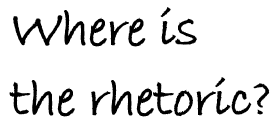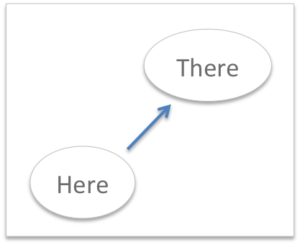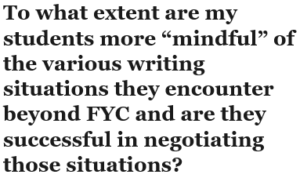Todd Ruecker, in his article, “Reimagining “‘English 1311: Expository English Composition’” as “‘Introduction to Rhetoric and Writing Studies,’” discusses his first-year composition (FYC) course redesign from a traditional course based around a textbook with readings and four essays representing the EDNA model: expository, descriptive, narrative, and  analytical to a rhetoric and writing studies (RWS) course with a writing about writing (WAW) approach. Interestingly, Ruecker acknowledges that though he says he uses a WAW approach, he finds it to be too broad a title for what he does within his course, in which he seeks to expose students to disciplinary discourses (89). Ruecker further explains that describing his course as using a writing about writing approach is problematic because it ignores rhetoric. Though, because he focuses on writing as a subject, he finds it to be the most suitable title to explain what he does.
analytical to a rhetoric and writing studies (RWS) course with a writing about writing (WAW) approach. Interestingly, Ruecker acknowledges that though he says he uses a WAW approach, he finds it to be too broad a title for what he does within his course, in which he seeks to expose students to disciplinary discourses (89). Ruecker further explains that describing his course as using a writing about writing approach is problematic because it ignores rhetoric. Though, because he focuses on writing as a subject, he finds it to be the most suitable title to explain what he does.
This contradiction makes me curious: If Ruecker’s purpose is to expose students to disciplinary discourses, then would a writing in the disciplines (WID) title or description not be more suitable? And what is his purpose for teaching such a course? Other than h is director’s initiative to “design courses more in line with RWS” (88). These questions are difficult to answer as Ruecker’s justification for his course redesign choices are unclear. Yet, on the last page of his article, Ruecker suggests that the goal of a FYC course is to challenge students “with intellectually demanding disciplinary content, material that better prepares students to write across a variety of academic and social contexts” (98). He seems to be speaking to writing across the curriculum (WAC) as a means to achieve transfer
is director’s initiative to “design courses more in line with RWS” (88). These questions are difficult to answer as Ruecker’s justification for his course redesign choices are unclear. Yet, on the last page of his article, Ruecker suggests that the goal of a FYC course is to challenge students “with intellectually demanding disciplinary content, material that better prepares students to write across a variety of academic and social contexts” (98). He seems to be speaking to writing across the curriculum (WAC) as a means to achieve transfer
even though there is no mention of WAC or transfer in the article. Perhaps his desire is to prepare students, but he is does not yet have the vocabulary to articulate what he is doing and what he desires to do. I sympathize with Ruecker here. I’ve been teaching using the WAW approach for over two years and at times have noticed gaps in my teaching but was not able to articulate what those gaps were because I did not have the vocabulary to do so.

Though Ruecker’s discussion begs several questions for me, it also provides me with a greater understanding of my current use of a WAW approach to FYC. Ruecker’s article reveals that a writing about writing approach may be a blend of several approaches. For example, my approach focuses on writing studies while emphasizing rhetorical theory and the transfer of knowledge. This realization also makes me question my textbook choice for the class—Downs and Wardle’s Writing About Writing, 2nd edition. Ruecker acknowledges that he has struggled to find a suitable text for a writing about writing class (89), and though I use Downs and Wardle’s text, I have always stressed that I do not use the “Downs and Wardle WAW approach.” Perhaps I am limiting my writing about writing approach through the use of this text and therefore my students’ experience in a writing studies course.
Ruecker, T. (2011). Reimagining “English 1311: Expository English Composition” as “Introduction to Rhetoric and Writing Studies.” Composition Studies 39(1), 87-111.

 In her article, “They Can Get There from Here: Teaching for Transfer through a ‘Writing about Writing’ Course,” Jennifer Wells explores her justification for and experience with teaching a high school composition course using a writing about writing (WAW) approach. Though much of my personal research focuses on first-year composition (FYC), Wells’ interests and mine intersect where Wells seeks to prepare her senior English students for unknown college writing contexts, including FYC. She understands that, as writing teachers, we are not experts in writing in the disciplines, but we can prepare our students for writing in the disciplines by cultivating an awareness within them that prepares them to write in a variety of contexts.
In her article, “They Can Get There from Here: Teaching for Transfer through a ‘Writing about Writing’ Course,” Jennifer Wells explores her justification for and experience with teaching a high school composition course using a writing about writing (WAW) approach. Though much of my personal research focuses on first-year composition (FYC), Wells’ interests and mine intersect where Wells seeks to prepare her senior English students for unknown college writing contexts, including FYC. She understands that, as writing teachers, we are not experts in writing in the disciplines, but we can prepare our students for writing in the disciplines by cultivating an awareness within them that prepares them to write in a variety of contexts. In this new curriculum, Wells is intentional to include opportunities that promote what Perkins and Salomon call “mindful abstraction,” or guiding students “to deliberately search for connections” (qtd. in Wells 57). Her curriculum is shaped around three units in which her students 1.) question, research, and define others’ definitions of “good writing,” 2.) explore potential discourse communities they will enter once in college, and 3.) research writing in their intended major in the writing in the disciplines unit. As students move from unit to unit, Wells prompts them to self-reflect on their writing discoveries. Though, she does not detail the specifics of how she manages this self-reflection activities.
In this new curriculum, Wells is intentional to include opportunities that promote what Perkins and Salomon call “mindful abstraction,” or guiding students “to deliberately search for connections” (qtd. in Wells 57). Her curriculum is shaped around three units in which her students 1.) question, research, and define others’ definitions of “good writing,” 2.) explore potential discourse communities they will enter once in college, and 3.) research writing in their intended major in the writing in the disciplines unit. As students move from unit to unit, Wells prompts them to self-reflect on their writing discoveries. Though, she does not detail the specifics of how she manages this self-reflection activities. s article was written in 2011, Wells was not yet sure how successful her writing about writing pilot had been. She explains that “questions still remain” and she would find out at her former students’ homecoming how they felt about college writing and their preparedness for it. But herein lies another intersection between Wells and I, as I too often wonder about the short-term and long-term effectivity of the writing about writing approach utilized in my classroom. To what extent are my students more “mindful” of the various writing situations they encounter beyond FYC and are they successful in negotiating those situations?
s article was written in 2011, Wells was not yet sure how successful her writing about writing pilot had been. She explains that “questions still remain” and she would find out at her former students’ homecoming how they felt about college writing and their preparedness for it. But herein lies another intersection between Wells and I, as I too often wonder about the short-term and long-term effectivity of the writing about writing approach utilized in my classroom. To what extent are my students more “mindful” of the various writing situations they encounter beyond FYC and are they successful in negotiating those situations? and Wardle, the instructor assumes the role of facilitator of knowledge rather than the deliverer, or teacher, of knowledge. Perhaps for this approach to be successful either in high school or FYC, students must construct their own knowledge (via the facilitation of the instructor); mindful abstraction therefore is not limited to an awareness of writing situations and personal writing choices, but it is an individual student’s ability to articulate their negotiation of different contexts. So while it is important that my students are negotiating various writing situations effectively, are they even constructing knowledge in the first place?
and Wardle, the instructor assumes the role of facilitator of knowledge rather than the deliverer, or teacher, of knowledge. Perhaps for this approach to be successful either in high school or FYC, students must construct their own knowledge (via the facilitation of the instructor); mindful abstraction therefore is not limited to an awareness of writing situations and personal writing choices, but it is an individual student’s ability to articulate their negotiation of different contexts. So while it is important that my students are negotiating various writing situations effectively, are they even constructing knowledge in the first place?